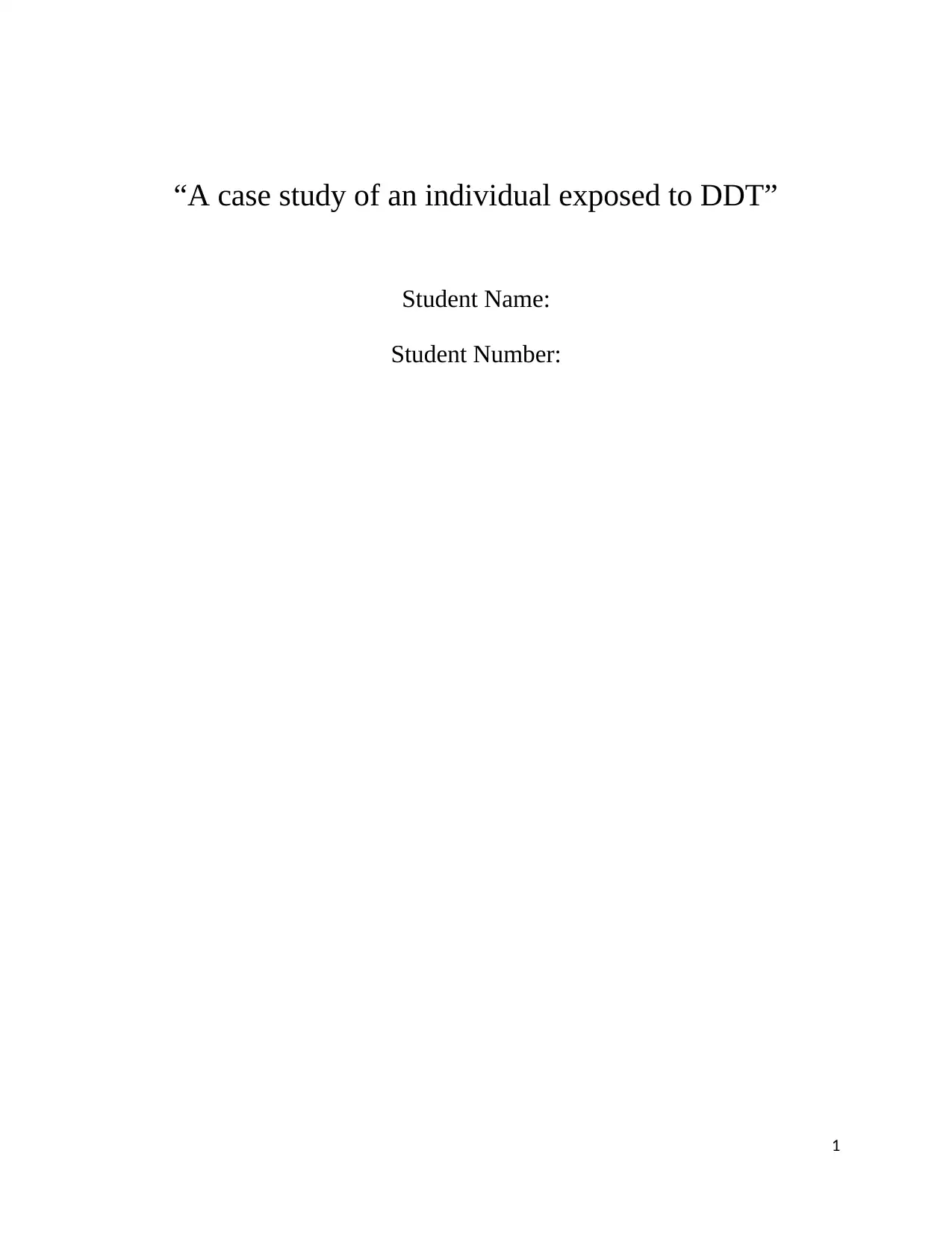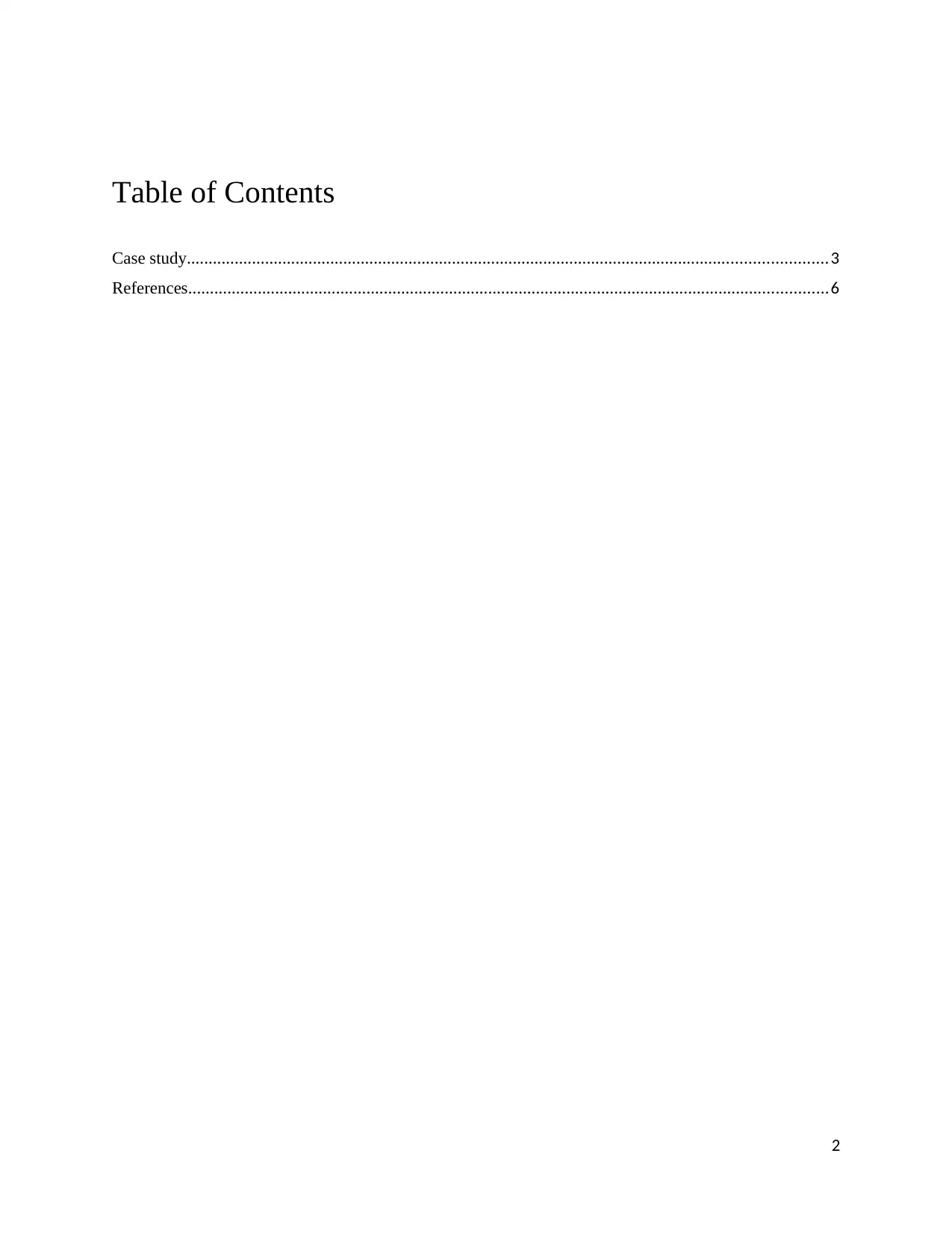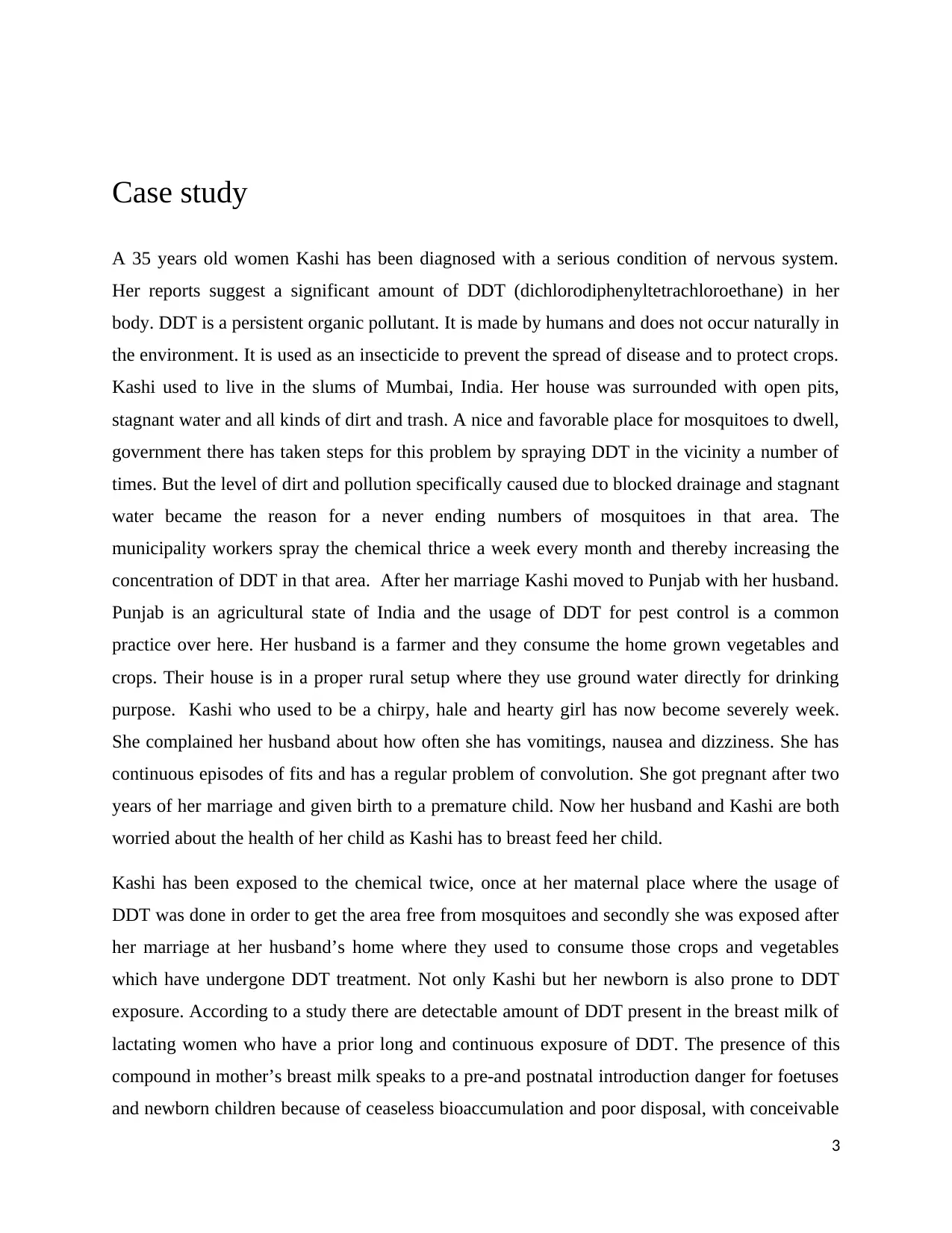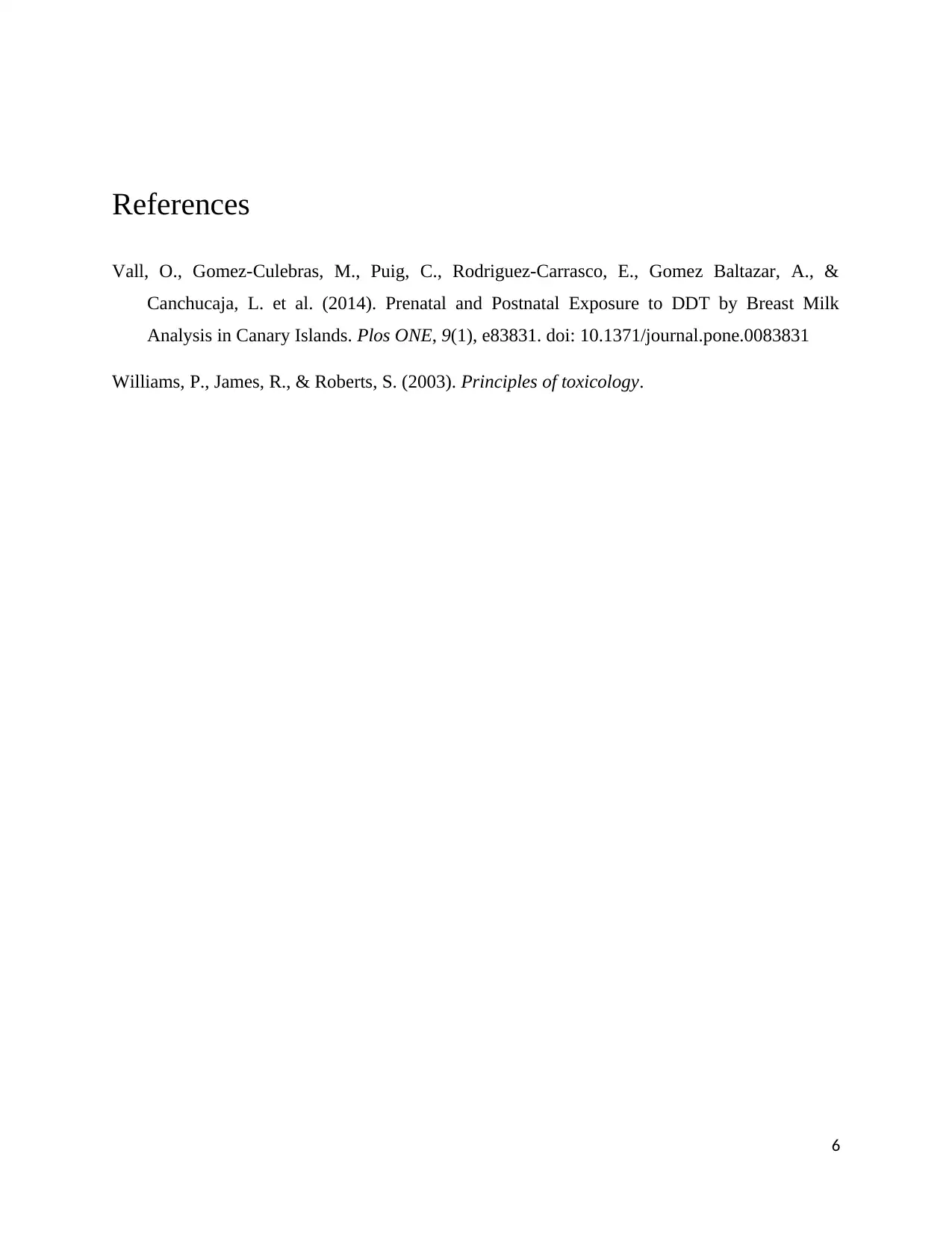Case Study: Health Effects of DDT Exposure in India
VerifiedAdded on 2023/01/06
|6
|1339
|44
Case Study
AI Summary
This case study presents the case of Kashi, a 35-year-old woman from India, who was diagnosed with a nervous system disorder due to significant DDT exposure. Kashi's exposure occurred in two phases: first, in the slums of Mumbai where DDT was sprayed to control mosquitoes, and later, in Punjab, where she consumed crops treated with DDT. The study details the pathways of exposure, including inhalation and ingestion through contaminated food and water. The effects of DDT on Kashi are chronic, leading to seizures, nausea, and the birth of a premature child. The study highlights the bioaccumulation of DDT, its impact on the nervous system, and the potential for exposure to the newborn through breast milk. It also discusses preventive measures and alternative pest control methods to minimize DDT exposure, emphasizing the need for clean food, water purification, and alternative methods to control mosquito populations. The case underscores the global implications of DDT use and the need for safer alternatives.

“A case study of an individual exposed to DDT”
Student Name:
Student Number:
1
Student Name:
Student Number:
1
Paraphrase This Document
Need a fresh take? Get an instant paraphrase of this document with our AI Paraphraser

Table of Contents
Case study...................................................................................................................................................3
References...................................................................................................................................................6
2
Case study...................................................................................................................................................3
References...................................................................................................................................................6
2

Case study
A 35 years old women Kashi has been diagnosed with a serious condition of nervous system.
Her reports suggest a significant amount of DDT (dichlorodiphenyltetrachloroethane) in her
body. DDT is a persistent organic pollutant. It is made by humans and does not occur naturally in
the environment. It is used as an insecticide to prevent the spread of disease and to protect crops.
Kashi used to live in the slums of Mumbai, India. Her house was surrounded with open pits,
stagnant water and all kinds of dirt and trash. A nice and favorable place for mosquitoes to dwell,
government there has taken steps for this problem by spraying DDT in the vicinity a number of
times. But the level of dirt and pollution specifically caused due to blocked drainage and stagnant
water became the reason for a never ending numbers of mosquitoes in that area. The
municipality workers spray the chemical thrice a week every month and thereby increasing the
concentration of DDT in that area. After her marriage Kashi moved to Punjab with her husband.
Punjab is an agricultural state of India and the usage of DDT for pest control is a common
practice over here. Her husband is a farmer and they consume the home grown vegetables and
crops. Their house is in a proper rural setup where they use ground water directly for drinking
purpose. Kashi who used to be a chirpy, hale and hearty girl has now become severely week.
She complained her husband about how often she has vomitings, nausea and dizziness. She has
continuous episodes of fits and has a regular problem of convolution. She got pregnant after two
years of her marriage and given birth to a premature child. Now her husband and Kashi are both
worried about the health of her child as Kashi has to breast feed her child.
Kashi has been exposed to the chemical twice, once at her maternal place where the usage of
DDT was done in order to get the area free from mosquitoes and secondly she was exposed after
her marriage at her husband’s home where they used to consume those crops and vegetables
which have undergone DDT treatment. Not only Kashi but her newborn is also prone to DDT
exposure. According to a study there are detectable amount of DDT present in the breast milk of
lactating women who have a prior long and continuous exposure of DDT. The presence of this
compound in mother’s breast milk speaks to a pre-and postnatal introduction danger for foetuses
and newborn children because of ceaseless bioaccumulation and poor disposal, with conceivable
3
A 35 years old women Kashi has been diagnosed with a serious condition of nervous system.
Her reports suggest a significant amount of DDT (dichlorodiphenyltetrachloroethane) in her
body. DDT is a persistent organic pollutant. It is made by humans and does not occur naturally in
the environment. It is used as an insecticide to prevent the spread of disease and to protect crops.
Kashi used to live in the slums of Mumbai, India. Her house was surrounded with open pits,
stagnant water and all kinds of dirt and trash. A nice and favorable place for mosquitoes to dwell,
government there has taken steps for this problem by spraying DDT in the vicinity a number of
times. But the level of dirt and pollution specifically caused due to blocked drainage and stagnant
water became the reason for a never ending numbers of mosquitoes in that area. The
municipality workers spray the chemical thrice a week every month and thereby increasing the
concentration of DDT in that area. After her marriage Kashi moved to Punjab with her husband.
Punjab is an agricultural state of India and the usage of DDT for pest control is a common
practice over here. Her husband is a farmer and they consume the home grown vegetables and
crops. Their house is in a proper rural setup where they use ground water directly for drinking
purpose. Kashi who used to be a chirpy, hale and hearty girl has now become severely week.
She complained her husband about how often she has vomitings, nausea and dizziness. She has
continuous episodes of fits and has a regular problem of convolution. She got pregnant after two
years of her marriage and given birth to a premature child. Now her husband and Kashi are both
worried about the health of her child as Kashi has to breast feed her child.
Kashi has been exposed to the chemical twice, once at her maternal place where the usage of
DDT was done in order to get the area free from mosquitoes and secondly she was exposed after
her marriage at her husband’s home where they used to consume those crops and vegetables
which have undergone DDT treatment. Not only Kashi but her newborn is also prone to DDT
exposure. According to a study there are detectable amount of DDT present in the breast milk of
lactating women who have a prior long and continuous exposure of DDT. The presence of this
compound in mother’s breast milk speaks to a pre-and postnatal introduction danger for foetuses
and newborn children because of ceaseless bioaccumulation and poor disposal, with conceivable
3
⊘ This is a preview!⊘
Do you want full access?
Subscribe today to unlock all pages.

Trusted by 1+ million students worldwide

malicious impacts on wellbeing (Vall et al., 2014). DDT is an organochlorine chemical
compound and these compounds can produce severe effects by acting on the nervous system.
Since they are lipophilic in nature, have a low vapor pressure and also they do not degrade easily
is the main reason for their bioaccumulation in the adipose tissue, or serum or milk (Williams,
James & Roberts, 2003). At first the exposure pathway was through air, as DDT sprayed in the
affected area was inhaled by the individual and could have acted severely on the nervous system.
Second was from the soil and it was a direct exposure through food as the vegetable they used to
consume were grown in a DDT exposed soil. Also the water that they used for drinking purpose
could also contain the traces of DDT as residues in soil due to its use in past can explain the
contamination.
DDT is an insecticide because it inhibits neuronal repolarization. Manifestations of DDT
poisoning in humans arise by the same mechanism. The chemical takes a longer time to degrade,
it is accumulated in the adipose tissue. The organ which is mainly affected is the central nervous
system due to which the individual is presenting such signs and symptoms like seizures, nausea,
fits etc. The effects of the exposure of the chemical are chronic in this case. Since Kashi has been
exposed for a very longer period of time, firstly she was exposed to the chemical from the air
containing that chemical then she was exposed to the chemical via food and water. This much
long exposure has deteriorated her condition. The birth of premature baby also suggests that
there are detectable amount of the chemical present in her breast milk too. The effects would
have been lower if the individual was not an adult. Since the bioaccumulation of this chemical
depends upon the quantity and duration of its exposure.
Manufacturing of DDT has almost been banned in all over the world, but India is still a
manufacturer and the largest consumer of this chemical. There are many replacement in the field
of agriculture for DDT that can be used for the removal of pests and for the betterment of crops
for example we can use bio control agents to prevent our crops from insects and other arthropod
manifestation the name of Trichoderma species is worth mentioning here as they are free living
fungi which are very common in root ecosystem. Baculovirus occupies second position in the list
of our bio control agent most of the Baculoviruses which are used as bio control agent are from
the genus Nucleopoly hedro virus. These viruses are excellent member for species specific,
narrow spectrum insecticidal application. They have been known to have no negative effects on
4
compound and these compounds can produce severe effects by acting on the nervous system.
Since they are lipophilic in nature, have a low vapor pressure and also they do not degrade easily
is the main reason for their bioaccumulation in the adipose tissue, or serum or milk (Williams,
James & Roberts, 2003). At first the exposure pathway was through air, as DDT sprayed in the
affected area was inhaled by the individual and could have acted severely on the nervous system.
Second was from the soil and it was a direct exposure through food as the vegetable they used to
consume were grown in a DDT exposed soil. Also the water that they used for drinking purpose
could also contain the traces of DDT as residues in soil due to its use in past can explain the
contamination.
DDT is an insecticide because it inhibits neuronal repolarization. Manifestations of DDT
poisoning in humans arise by the same mechanism. The chemical takes a longer time to degrade,
it is accumulated in the adipose tissue. The organ which is mainly affected is the central nervous
system due to which the individual is presenting such signs and symptoms like seizures, nausea,
fits etc. The effects of the exposure of the chemical are chronic in this case. Since Kashi has been
exposed for a very longer period of time, firstly she was exposed to the chemical from the air
containing that chemical then she was exposed to the chemical via food and water. This much
long exposure has deteriorated her condition. The birth of premature baby also suggests that
there are detectable amount of the chemical present in her breast milk too. The effects would
have been lower if the individual was not an adult. Since the bioaccumulation of this chemical
depends upon the quantity and duration of its exposure.
Manufacturing of DDT has almost been banned in all over the world, but India is still a
manufacturer and the largest consumer of this chemical. There are many replacement in the field
of agriculture for DDT that can be used for the removal of pests and for the betterment of crops
for example we can use bio control agents to prevent our crops from insects and other arthropod
manifestation the name of Trichoderma species is worth mentioning here as they are free living
fungi which are very common in root ecosystem. Baculovirus occupies second position in the list
of our bio control agent most of the Baculoviruses which are used as bio control agent are from
the genus Nucleopoly hedro virus. These viruses are excellent member for species specific,
narrow spectrum insecticidal application. They have been known to have no negative effects on
4
Paraphrase This Document
Need a fresh take? Get an instant paraphrase of this document with our AI Paraphraser

plants, mammals, birds, fishes or even non targeted organism. This approach of using bio control
agent like this are very beneficial when an ecological sensitive area is being treated. Preventive
measures could be taken in order to minimize this exposure like, we should always clean the
food items properly before cooking them. Also we can ensure that if there are past traces of DDT
in the soil which could also infect the ground water then measures could be taken to purify that
water before drinking.
But due to its significantly remarkable efficacy in curbing malaria causing mosquitoes its usage
for spraying as insecticide has not yet been minimized but it does not mean there are no other
option to save our self from malaria causing mosquitoes, we can use preventive steps in order to
avoid its contact to our system, we should take measures of avoiding those conditions which
could give rise to the favorable conditions for the malaria causing mosquitoes to breed like we
should check for any waste or stagnant water in our localities that could give rise to the birth of
mosquitoes. We should try to keep our surroundings clean and pollution free. We can use wire
mess on window panels so that entry of mosquitoes can be retarded. Secondly we can introduce
Gambusia which is a fish in ponds which feeds on mosquito larva and thereby preventing
mosquitos’ growth, it can be used as a substitute of DDT.
5
agent like this are very beneficial when an ecological sensitive area is being treated. Preventive
measures could be taken in order to minimize this exposure like, we should always clean the
food items properly before cooking them. Also we can ensure that if there are past traces of DDT
in the soil which could also infect the ground water then measures could be taken to purify that
water before drinking.
But due to its significantly remarkable efficacy in curbing malaria causing mosquitoes its usage
for spraying as insecticide has not yet been minimized but it does not mean there are no other
option to save our self from malaria causing mosquitoes, we can use preventive steps in order to
avoid its contact to our system, we should take measures of avoiding those conditions which
could give rise to the favorable conditions for the malaria causing mosquitoes to breed like we
should check for any waste or stagnant water in our localities that could give rise to the birth of
mosquitoes. We should try to keep our surroundings clean and pollution free. We can use wire
mess on window panels so that entry of mosquitoes can be retarded. Secondly we can introduce
Gambusia which is a fish in ponds which feeds on mosquito larva and thereby preventing
mosquitos’ growth, it can be used as a substitute of DDT.
5

References
Vall, O., Gomez-Culebras, M., Puig, C., Rodriguez-Carrasco, E., Gomez Baltazar, A., &
Canchucaja, L. et al. (2014). Prenatal and Postnatal Exposure to DDT by Breast Milk
Analysis in Canary Islands. Plos ONE, 9(1), e83831. doi: 10.1371/journal.pone.0083831
Williams, P., James, R., & Roberts, S. (2003). Principles of toxicology.
6
Vall, O., Gomez-Culebras, M., Puig, C., Rodriguez-Carrasco, E., Gomez Baltazar, A., &
Canchucaja, L. et al. (2014). Prenatal and Postnatal Exposure to DDT by Breast Milk
Analysis in Canary Islands. Plos ONE, 9(1), e83831. doi: 10.1371/journal.pone.0083831
Williams, P., James, R., & Roberts, S. (2003). Principles of toxicology.
6
⊘ This is a preview!⊘
Do you want full access?
Subscribe today to unlock all pages.

Trusted by 1+ million students worldwide
1 out of 6
Your All-in-One AI-Powered Toolkit for Academic Success.
+13062052269
info@desklib.com
Available 24*7 on WhatsApp / Email
![[object Object]](/_next/static/media/star-bottom.7253800d.svg)
Unlock your academic potential
Copyright © 2020–2025 A2Z Services. All Rights Reserved. Developed and managed by ZUCOL.